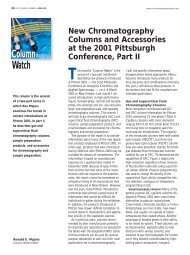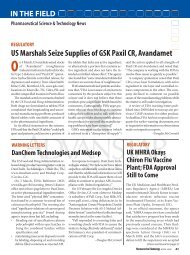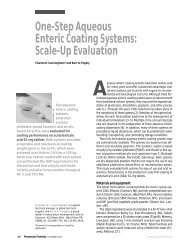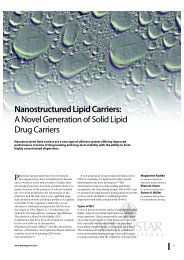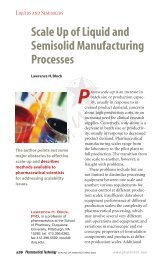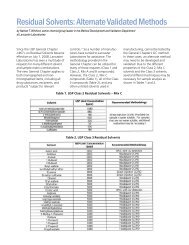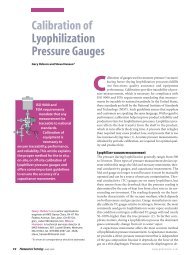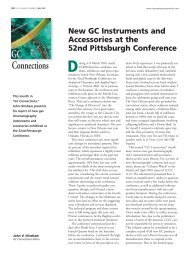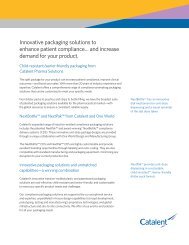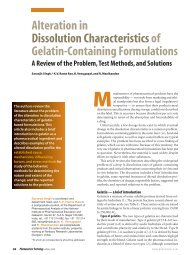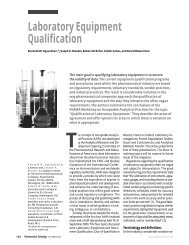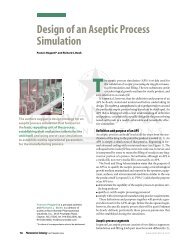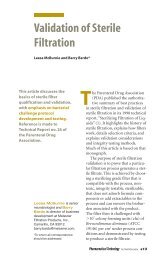Synthetic Excipients Challenge All-Natural Organics Synthetic ...
Synthetic Excipients Challenge All-Natural Organics Synthetic ...
Synthetic Excipients Challenge All-Natural Organics Synthetic ...
You also want an ePaper? Increase the reach of your titles
YUMPU automatically turns print PDFs into web optimized ePapers that Google loves.
Special Report<br />
An excipient's path to the National Formulary<br />
After a new excipient has been used in an<br />
FDA-approved drug, the excipient manufacturer<br />
can submit a monograph of the excipient<br />
to the United States Pharmacopeia (USP).<br />
USP's web site, www.usp.org, posts the requirements<br />
for new submissions, called “Requests<br />
for Revision,” and details what should<br />
be included in the submission package.<br />
Once USP receives the company's submission,<br />
it first makes an initial evaluation of the<br />
completeness of the data. If it determines that<br />
all the required data are included, it will send<br />
the submission on to an expert committee for<br />
review. The committees are generally composed<br />
of representatives from the pharmaceutical<br />
manufacturing industry, government (including<br />
FDA), and academia.<br />
The expert committee will then make a<br />
more-thorough evaluation of the submission<br />
package. If accepted, it will be incorporated in<br />
the Pharmacopeial Forum (PF), which is published<br />
every other month, for public review<br />
and comment. Anyone with an interest in that<br />
excipient, called a stakeholder, can send comments,<br />
but those comments must be substantiated<br />
with appropriate data or reasonable<br />
information.<br />
After the comments are received, the complete<br />
package is sent back to the expert committee.<br />
If there are no comments, the monograph<br />
proposal is voted on by the expert<br />
committee to become an official monograph<br />
in the USP–NF after a minimum of 60 days<br />
(typically 90 days) have passed since its publication<br />
in the PF.<br />
When there are comments, the committee<br />
will decide whether to revise the monograph<br />
accordingly or to reject them. If the monograph<br />
is revised, then it must be published in the PF<br />
a second time, then can be voted to become an<br />
official monograph 60 days after publication.<br />
If a monograph requires only one publication<br />
in the PF, it can become official in approximately<br />
6–8 months. When a second publication<br />
cycle is required, the entire process can take<br />
15 months or longer.<br />
Excipient manufacturers easily disagree with<br />
these definitions when describing their products<br />
because so much chemistry is involved in the manufacturing<br />
process. As a result, the term synthetic is<br />
frequently used to encompass both types.<br />
Applications and advantages<br />
<strong>Synthetic</strong> excipients are used in the manufacture<br />
of tablets to bind the tablet together, reduce diewall<br />
friction between the tablet and the tableting<br />
press, control pH balance, and to disintegrate<br />
the tablet in the stomach once it has been ingested.<br />
They’re used for just about every function<br />
of an inactive ingredient except as bulking<br />
agents, which are usually natural products. In<br />
parenterals, synthetics are used as solubilization<br />
agents to make actives more soluble, and therefore,<br />
more deliverable.<br />
<strong>Synthetic</strong>s also offer other benefits over natural<br />
excipients. Because they’re not extracted<br />
from animal materials, they’re free of transmissible<br />
diseases—a characteristic that may be of<br />
increased importance among manufacturers and<br />
regulators in light of the recent case of a BSEinfected<br />
cow found in the United States last year.<br />
The absence of plant or animal material in synthetics<br />
also eliminates concerns posed by genetically<br />
modified organisms (GMOs), which can<br />
also interfere with the safety and acceptability of<br />
a drug formulation.<br />
Another benefit of synthetics compared with<br />
natural excipients is that they can be produced to<br />
a certain specification because there is more control<br />
over the manufacturing process. Most naturalbased<br />
polymers aren’t chemically identical because<br />
of the variability that exists in nature. For<br />
example, depending on changes in weather from<br />
one year to the next, the structure and properties<br />
of natural materials can also vary slightly—an effect<br />
avoided with synthetics, which are synthesized<br />
in chemical reactors.<br />
Joseph Zeleznik, senior scientist at excipients<br />
manufacturer JRS Pharma (Patterson, NY), points<br />
to magnesium stearate as a good example of a natural<br />
material versus a synthetic. “Manufacturing<br />
controls are just not that stringent because they<br />
can’t be. Because magnesium stearate is a naturally<br />
derived product, it possesses a great deal of<br />
inherent variability—not only from batch to batch<br />
but from manufacturer to manufacturer as well,”<br />
says Zeleznik.<br />
Such variability in natural excipients can be problematic<br />
for drug manufacturers because once their<br />
formulation has been approved by FDA, it becomes<br />
difficult to change the formulation components or<br />
component levels that were used in the clinical trials.<br />
If any variability exists, either in the raw materials<br />
or manufacturing process, a company will have<br />
to spend more time and money proving that there<br />
are no adverse effects as a result of the change.<br />
40 Pharmaceutical Technology APRIL 2004 www.pharmtech.com



